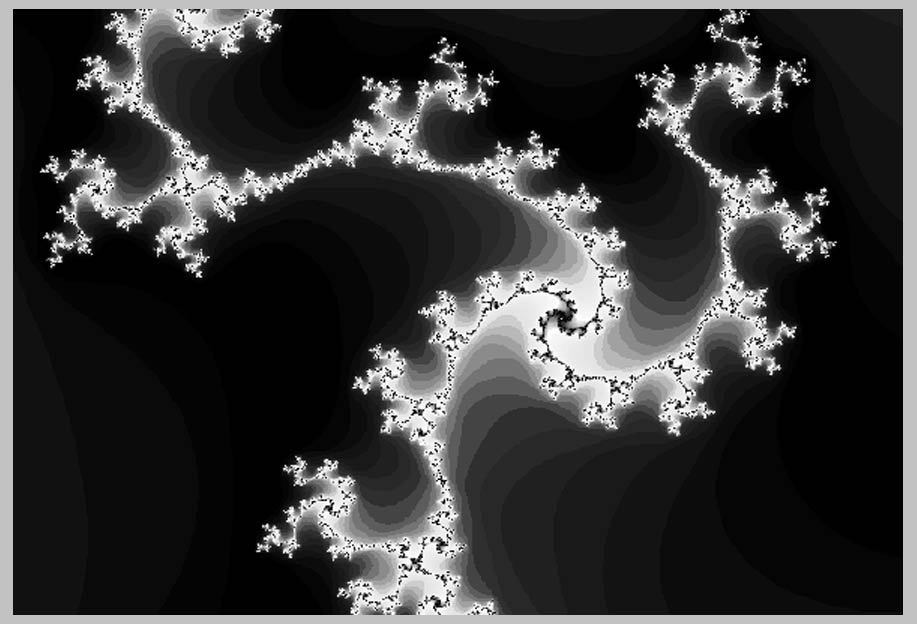

FRACTAL FORMS: Birth of Form, generated with XaoS, [ click photo for next . . . ]
a kind of computer spaceship one can fly through fractal space,
and then make snapshots of patterns that catch one's fancy along the way . . .


FRACTAL FORMS: Birth of Form, generated with XaoS, [ click photo for next . . . ]
a kind of computer spaceship one can fly through fractal space,
and then make snapshots of patterns that catch one's fancy along the way . . .
FRACTALS AS PATTERNS OF RHYTHMIC MOVEMENT
Fractals are the discovery of the convivial and brilliant French
mathematician, Benoit Mandelbrot. Mandelbrot noticed already when he
was a young student that he had a unique ability to solve equations by
visualizing them in his mind’s eye. Later, this gift became essential
in his quest for a new geometry, one not based on the simple squares
and triangles of Euclidian textbooks, but a geometry that would more
accurately describe the complex forms of nature like the serpentine
flowforms of rivers and coastlines, the ragged edges of ridgelines, or
the pattens we see pass by everyday in the heavens above. Indeed, he
is constantly reminding us that “clouds are not spheres.”
Whereas the details of the formal mathematics upon which fractals
are based are for me I’m afraid something like a horizon I’m strongly
drawn to but which retreats as I try to come near, I greatly enjoy looking
at them as a kind of meditation on form. I experience fractals like
I do all natural form, not as static shapes, but rather as complex
composites of rhythmic movements. In other words, I experience them as
a kind of abstract music.
The three key generative principles of fractals are amazingly simple.
In my own words, they are:
(1) self-similar patterns;
(2) manifested at differences of scale;
(3) by means of an, in theory, infinite number of
rhythmic repetitions or iterative movements.
Music indeed! Any composer, or photographer, or poet would do well
I think to study seriously Mandelbrot’s work. And, of course, because of
the in principle unlimited number of steps involved in their generation,
we can make good use of the largely untapped processing power of the
now ubiquitous home computer to make them visible to us.
That is, or we can just step outside and study the great and wonderful
symphony of the shapes of flowers, of ice crystals, or of the clouds
overhead!
—On the road in the Northwest of America.
THE MASTER & THE APPRENTICE
Just as assuredly as the moon moves the tides, intelligence moves the
young mind in mysterious and subtle ways. The teacher is the one who
discovers first the rhythm of this movement in him- or herself, and then
awakens it just as naturally and invisibly in the student.
In this way, the teacher is the one who protects the student from a meta-
physics of education that forces children into a career of tourism on the
periphery of learning and creativity. How much better to find one’s call-
ing early in life, when learning is still largely an unselfconscious affair,
and skill and aesthetic sensibility become easily—as the apt expression
has it—second nature.
RESONANCE
Imagine a series of nested circles, one within the other, expanding into
natural time and space. Then, imagine a kind of harmony, a kind of
mutual fitting together, of the movements of the circles, one within
the other.
Now imagine putting the whole of this movement of expanding, nested
circles inside a small, tight, little leaden box, thereby isolating and
fragmenting the movement from the larger world. This is what happens
to Art and Culture when they are no longer rooted or nested within the
natural world. Once this happens, one of the primary tasks of Art and
the Artist is to somehow—smash the box.
GARDEN VARIETY VERSE
Literary journals are to poetry what formal botanical gardens are to
wild mountain plants. There they all are! Bright Snow lily, Gentian,
Arnica, even a beautiful patch of Cotton grass next to the pool. All
precisely labelled and seemingly well-fed. And so easy to tell apart!
But after a while, I’ve noticed that one starts reading the signs first.
That’s bad.
THE LITTLE CLAVIER please preview 150 of 631 pages
w/ my black & white photography [opens in new window]
Follow @cliffcrego
Featured gallery, mountain water . . . .Please visit my Living Water Gallery—some of
the best of my flowform photography w/ a selection of the highest quality
prints & frames . . . [ mouse over for controls / lower right fro full-screen ]
All Photographs & texts by Cliff Crego © 1999 -2012 picture-poems.com
(created: III.15.2012)